 полная версия
полная версияNature's Teachings
We are all familiar with Domes, especially when the Dome of St. Paul’s is the most conspicuous object in our metropolis. Few persons, however, except professional architects and builders, seem to ask themselves the principle on which the Dome is constructed.
The strength of the arch is well known, and the Dome is practically a number of arches, affording material support to each other, and so enormously increasing the strength of the edifice.
A good idea of the Dome principle may be formed by taking two croquet hoops, placing them at right angles to each other, tying them together at the intersection, and pushing the ends in the ground. Even by this very simple arrangement considerable strength can be obtained; but, if the hoops be sufficiently multiplied to form a close Dome, it will be evident that the strength will be correspondingly increased.
So strong, indeed, is the Dome, that it could be made without mortar or cement, although, of course, its strength is increased by their use. A very good example of a Dome thus constructed is found in the “igloo,” or snow-hut of the Esquimaux, which has already been described.
As to the example which I have selected, it would have been easy enough to have chosen one of the great Domes of the world, such as St. Peter’s at Rome, St. Maria del Fiore at Florence, St. Paul’s of London, or St. Geneviève or the Invalides of Paris.
I have, however, selected the present example on account of the thinness of its walls, the fragility of its material, and the enormous pressure which it has to undergo. This is the “Receiver” of the Air-pump. It is made of glass not thicker than an ordinary tumbler, and yet, even when exhausted of air, it will resist the pressure of the atmosphere for days together.
When it is remembered that the Receiver is deprived of its internal air, and therefore has to resist a pressure equal to fifteen pounds on every square inch of its surface, it may be imagined how strong the Dome is. Were the top or either side to be flat, it would be crushed as soon as a vacuum was formed sufficient to deprive it of the support of the air within.
A glance at the illustration will show how the Receiver is modelled on the same plan as the Human Skull, the outlines being curiously similar. It is this formation which imparts such strength to so thin a set of bones as those which compose the human skull as enables them to protect a sensitive organ like the brain, on which both reason and life itself depend.
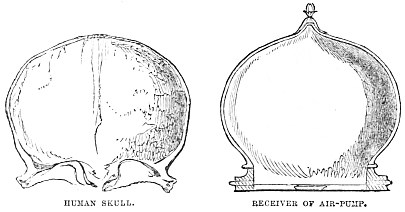
Eggs also form good examples of the wonderful strength obtained by this principle, their thin shells protecting the yolk and the white, as well as the chick through its progress to maturity.
The last subject in this chapter is a curious example of an evidently accidental resemblance in form.
The figure on the right of the accompanying illustration will at once be recognised as one of those Salad-dressing Bottles which try to conceal by their shape the small volume of their contents.
That on the left represents one of the many forms through which the Medusa passes before it attains its perfect form. It was long thought to be a separate creature, and was known under the scientific name of Strobila. Modern researches have, however, made the discovery that it is one of the transitional stages between the creature known as the Trumpet-hydra (Hydra tuba) and the Medusa, popularly known as Jelly-fish.
The former almost exactly resembles the Hydra of our fresh waters. It is a tiny transparent gelatinous bag—so transparent as to be scarcely perceptible, and with some thirty or forty long and delicate tentacles hanging from its open end. These tentacles are used in catching the minute creatures on which it feeds. It is fixed, and, to use Mr. Rymer Jones’s simile, looks like a beautiful silk-like pencil waving amidst the water. Its length is not quite half an inch.
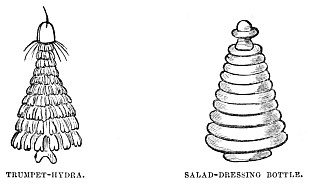
That it should be identical with the remarkable form shown in the illustration seems impossible, but such is the case. Its body becomes contracted as if tied with strings, and every segment thus formed develops a set of tentacles, breaks away, and swims off in the form of a Medusa. The upper segment is exhibited as undergoing this process.
The figure is magnified so as to show the structure better, its right length being about one-third of an inch. A full and graphic history of this creature and its manifold changes may be found in Mr. Rymer Jones’s “Aquarian Naturalist.”
It is not likely that the inventor of the Salad-dressing Bottle ever saw a Hydra, but the resemblance is strangely exact.
ACOUSTICS
CHAPTER I.
PERCUSSION.—THE STRING AND REED.—THE TRUMPET.—EAR-TRUMPET.—STETHOSCOPE
The Science of Sound.—Rhythmical Vibrations.—The Drum.—Primitive Drums.—The Solid and Hollow Log.—The Bass Drum and Kettle-drum.—African Drums.—Gnostic Gems and the Ashanti Drum.—Tympanum, or Drum of the Human Ear, and its Mechanism.—An artificial Tympanum.—The String.—The Bow and the Harp.—The Harpsichord and the Zither.—The Bow and the Violin.—The Cricket.—The Vibrator, or Reed.—The Jew’s Harp and Harmonium.—The Cicada and its Song.—Harmonics upon Strings.—The Æolian Harp.—Harmonics upon the Trumpet.—The Trombone.—Trachea of the Swan.—The Ear-trumpet.—The Sea-shell.—The Stethoscope.—Savage Food.—The Aye-aye.—The Siren and its Uses.—Echo and Whispering Gallery.
IN a work of this nature it would be absolutely impossible, not to say out of place, to give an account of so elaborate a subject as Acoustics, i.e. the science of Sound. Suffice it to say, that all sounds are produced by the vibration of air, and that the fewer vibrations, the lower is the sound, and vice versâ.
When such vibrations are produced regularly, they form Musical sounds, but, if irregularly, the sounds can be only distinguished under the term of Noise. The earliest germ of music lies in certain savage races, who, as long as they can maintain a rhythmical beat on any resonant substance, do not particularly care what it is. A hollow tree is a splendid instrument in their opinion, but, if this cannot be had, a dry log of wood will answer the same purpose.
Some tribes, more ingenious than others, cut a deep groove upon the upper surface of a log, hollow it through this groove, and then hammer away at it to their hearts’ content. The next move was to cut off a section of the trunk of a tree, hollow it, set it on end, and then beat it on the sides.
Lastly, some one hit upon the idea that if the open upper part of the hollowed log were covered with a tightly stretched membrane, and that if the membrane, instead of the log, were beaten, the resonance would be increased. In consequence, the real Drum was invented, and seems to have existed from time immemorial in parts of the world so distant that they could not have had any communication with each other.
Take, for example, the well-known “Bass Drum” of our bands, which is shown on the right hand of the figure. We make it a very ornamental article, with frame of metal, and heraldic decorations of all kinds.
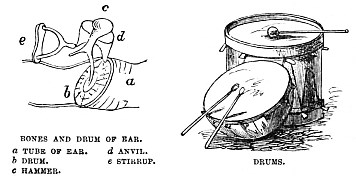
Lying against it is one of a pair of Kettle-drums, such as are always seen in mounted bands. They look very easy to play, but, if the reader will try a pair, he will soon find his mistake.
But there are savage tribes of Western Africa who make Drums of such wonderful power that their sullen roar is heard for miles around, as their slow, triple beat summons the tribe to arms like the fiery cross of the Highland clans. As to shape, lightness, and beauty, our Drums are infinitely superior to theirs, but, so far as I can gather from personal and written narratives of African travellers, none of our Drums surpass theirs in richness, depth of tone, and power of carrying sound.
Sometimes these Drums, instead of being mere cylinders, are carved into the most strange and fantastical patterns. I possess one of these curious Drums, brought from Ashanti, and carved out of a solid piece of wood.
The strange point in it is, that it represents a double head carrying, after all negro fashions, a sort of vessel upon it. One part of the head represents a human head (not that of a negro), while the other merges gradually into an eagle’s head and beak. It is, in fact, a Gnostic gem, and would pass muster as such if it had been engraved on chalcedony, cornelian, or other semi-precious stones which are employed in the seal-engraver’s art.
Upon this composite head is placed the Drum itself, which is also cut out of the solid block, and which, after the fashion of West African Drums, has a hole on one side.
This remarkable instrument was given to me by an old merchant captain, who brought it himself from West Africa, and who, when I made his acquaintance, had actually painted it all kinds of colours, planted it in his garden, and was using the Drum as a flower-pot. Of course, as soon as it came into my possession, I put it in “pickle,”—i.e. a strong solution of alkali,—brushed off the paint, and placed it in my museum, where it is now.
On the left hand of the illustration on page 514 is given a sort of map or chart of the human Ear, with its internal Drum, or Tympanum, as it is scientifically termed.
It is by the vibration of this Drum that hearing is made possible, the vibrations of the air being transmitted to the Drum by means of a beautiful bony apparatus, termed the Hammer, Anvil and Stirrup. Sometimes the action of the Drum is partially checked, and then the sufferer is said to be “hard of hearing.” Sometimes it is broken, or its action totally clogged, and then he is said to be “stone deaf.” There have been cases where an artificial tympanum has been inserted, and answered its purpose fairly well.
The String and ReedIt has previously been mentioned that all sounds are owing to vibrations of the air. But there are many ways of producing these vibrations, and each mode gives a different quality of tone. We have already seen, by means of the drum, how sound is produced by percussion. We shall now see how sounds can be produced by the vibrations of a String.
If the string of a bow be pulled and smartly loosed, the result is a distinctly musical sound, higher or lower according to the length and tension of the string. Perhaps some of my readers may recall the passage in Homer’s “Odyssey,” where Ulysses strings the fatal bow:—
“Heedless he heard them; but disdained reply,The bow perusing with exactest eye.Then, as some heavenly minstrel, taught to singHigh notes responsive to the trembling string,To some new strain when he adapts the lyre,Or the dumb lute refits with vocal wire,Relaxes, strains, and draws them to and fro;So the great master drew the mighty bow,And drew with ease. One hand aloft displayedThe bending horns, and one the string essayed.From his essaying hand the string let fly,Twanged short and sharp, like the shrill swallow’s cry.”The Harp is, in fact, nothing but a magnified bow, with a number of strings of graduated length and tension. Some very beautiful experiments have been made on this subject by the Rev. Sir F. A. G. Ouseley, Professor of Music at Oxford, who stretched a string of sixty-four feet in length, and found that although, when vibrating, it must produce a note, there was no human ear that could distinguish it. Yet, if combined with other musical instruments, it would probably do its work well. The theory of the vibrations will be briefly described on another page.
These vibrations may be produced in various manners. The string may be pulled with the fingers, as in the harp, the guitar, the zither, or even the violin, &c., in pizzicato passages.
The old harpsichord, now an instrument vanished into the shadows of the past, pulled the strings with little strips of quill, acting like the thumb-ring of the zither-player. The “plectrum” of the ancients acted in the same manner, and the Japanese have at the present day a sort of guitar played with a plectrum. I have heard it, but cannot particularly admire the effect, the notes appearing to be without feeling, and as if they were played on a barrel-organ.
Sometimes, as in our modern pianos, the strings are struck by hammers instead of being pulled by fingers, plectrum, or goose-quill.
The most ingenious mode of causing musical vibration is the Bow, which is too familiar to need a detailed description. Suffice it to say that it really is a modified bow, the place of the string being supplied by a flat band of horsehair, which is drawn over the string, and so causes it to vibrate. In order to enable the bow to grip the string, it is rubbed with resin almost as often as a billiard-player chalks his cue.
Some skill is required even in producing a sound by the bow. It looks as if any one could do it, but a novice, if he extorts any sound at all, never rises above a squeak. When I took my first violin lessons, nearly thirty years ago, I was so horrified at the discordant sounds elicited from the instrument, that I retired to the topmost garret of the house in order not to hurt any one’s feelings except my own.
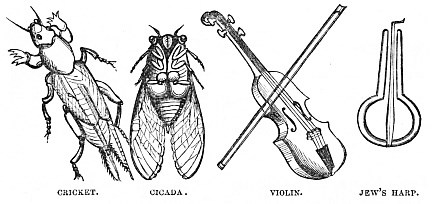
On the left hand of the illustration is seen a well-known example of the imitation of Nature by Art. This is the common Cricket, whose loud shrill call is more familiar than agreeable.
Some years ago, while engaged on my “Insects at Home,” I gave much time to the examination of the structures by which such a sound can be produced. On the under side of the wing-covers, or “elytra,” as they are scientifically termed, are notched ridges, which, when examined with a moderate power of the microscope, have something of this appearance ~~~~~~~. The friction of these notches produces the musical sound, which, as the reader will see, is exactly analogous to the friction of the bow upon the string.
Next we come to the Vibrator, sometimes called the Reed. It is introduced into various musical instruments, such, for example, as the harmonium, the clarionet, the oboe, the bassoon, and various organ pipes.
The simplest form of the Vibrator is shown in the Jew’s Harp, as it is popularly called, though it is not a harp, and has nothing to do with Jews.

The word is really a mistaken pronunciation of “jaw’s harp,” because the instrument is held against the teeth, while its tongue is vibrated by strokes of the finger. These vibrations affect the air within the mouth, and, by expanding or contracting the mouth, the sound is lowered or raised according to the laws of Acoustics. Of course, the range of notes is very small, being limited to those of the common chord, and even they being attainable only by a practised performer. Very good effects, however, have been produced by means of a series of Jew’s Harps, set to different tones by loading the end of the tongue with sealing-wax or similar substances.
An apparatus constructed on the same principle is to be found in the vocal organs of the male Cicada. If one of these insects be examined on the lower surface, two curious and nearly circular flaps will be seen, just at the junction of the thorax with the abdomen. It is by the action of these two little vibrators that the insect is able to produce a sound so loud, that in calm weather it may be heard at the distance of a mile.
The accompanying illustration is, in fact, a sort of chart as to the vibration of sound.
On the right is shown the Æolian Harp, with its upper lid raised, so as to show the structure of the strings. These are all tuned to the same note, the present D being generally accepted as being most free from false tuning, and less liable for the errors of “temperament.” Several of the strings are an octave lower than the others, but the tonic is always the same.
The instrument is placed in a current of air, generally in a window, with the sash let down upon it, and the air-currents set the strings vibrating in a most wonderful manner.
There is no need for human fingers to touch them, but they automatically divide themselves into the component parts of the common chord, and produce octaves, fifths, and thirds ad infinitum.
On the left hand of the same illustration is exhibited a string of the same length and tension, vibrating in two different ways. The upper figure shows it divided into three portions, each of which gives the fifth above the tonic, and all of which, when sounding simultaneously, give a fulness and richness to the tone which could only be attained otherwise by three distinct instruments. All players of stringed instruments know how invaluable are these harmonics, without which many passages of well-known music could not be played, and which are produced by “damping,” and not pressing the strings.
So, if the string be lightly touched, or damped at the crossing portion at either end, the result will be that the string divides itself into three portions, and all three resound simultaneously.
The lower string is vibrating in thirds, having divided itself into four portions. If it were damped in the middle, it would divide itself into two portions, and sound octaves.
The subject is a most interesting one, but our space is nearly exhausted, and we must pass to another branch of it.
In all brass instruments furnished with a mouthpiece, and not with a reed, the notes are obtained by vibrations of the enclosed air, caused by the movement of the lips. They are all set to some definite tonic, sometimes C natural, but mostly to a flat tone, such as B flat or E flat.
Taking the ordinary military trumpet or bugle as an example, we have (when we have learned how to play it), first, the tonic. By alteration of the lips we get the octave above the tonic. Then comes the fifth; then the third, which is, in fact, another octave; and then a few other notes, the truth of which depends on the ear of the player.
Now, all these notes are obtained by means of the lips, which set the column of air vibrating, and divide it into harmonics. The apparently complicated bugle-calls of the army are nearly all formed from four notes only, i.e. (taking C as the tonic) C G C E G.
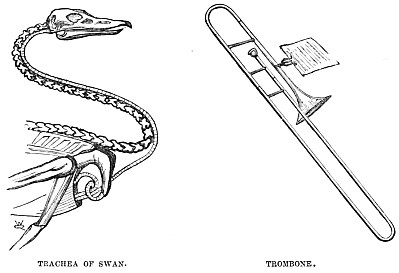
The Trombone, which is shown on the right hand of the illustration, has the advantage of being lengthened at will, and thus giving the performer a fresh tonic, and consequently another series of harmonics. Valved and keyed instruments have a similar advantage, the one acting by lengthening, and the other by shortening, the column of air. The former is infinitely the better plan, as it sets more harmonics vibrating, and consequently gives a greater richness of tone.
A familiar example of this is to be found in the Ophicleide and Euphonium. The former is eight feet in total length, and alters its tonic by eleven keys, which shorten the column of air. The latter is of the same length, but, by the employment of valves, can be made sixteen feet in length. Consequently the euphonium has practically killed the ophicleide, just as the ophicleide killed the serpent. The cornet-à-pistons, the brass contra-basso, the flugel horn, the tenor sax-horn, &c., are all constructed on the same principle.
On the left hand of the illustration is shown the wonderful apparatus by means of which the Swan produces its far-resounding cry. The windpipe, or “trachea,” as it is technically named, passes down the neck, protected by the bones, until it reaches the chest. There it leaves them, enters the cavity of the chest, and contorts itself in such a manner as to obtain greater length, just as is the case with the trombone and valved instruments.
Acoustics as Aids to SurgeryWe have already seen how the air-vibrations poured in at the small end of the trumpet can make resonant notes. We have now to see how the reverse process can be employed, and sounds poured into the larger end be conveyed to the ear.
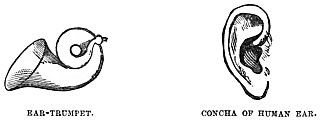
The Ear-trumpet is a familiar example of such an instrument, and, as it is shown in the illustration, there is no need of further description. It is rather remarkable, by the way, that the length of tube does not seem to interfere with the conveyance of sound, as may be seen by the speaking-tubes which are now so common in private houses, hotels, and offices.
I know of one church in which there is a special seat for deaf persons. The reading-desk and pulpit are both fitted with the large ends of Ear-trumpets. From them pass tubes under the flooring, and so into the seat, where they can be applied to the ear of the deaf worshippers.
On the right hand is the “Concha,” as it is called, of the human ear, which is evidently constructed for the purpose of collecting and concentrating sounds. Instinctively, if we wish to near any sound more distinctly, we place the open hand behind the ear, so as to enlarge its receptive capacity, and send a greater volume of sound into the ear.
The well-known experiment of holding a shell to the ear so as to hear the murmur of the sea is due to the same cause, the shell collecting, though in a mixed manner, all the surrounding sounds, and making a murmur which really resembles the distant wash of the waves upon the shore.
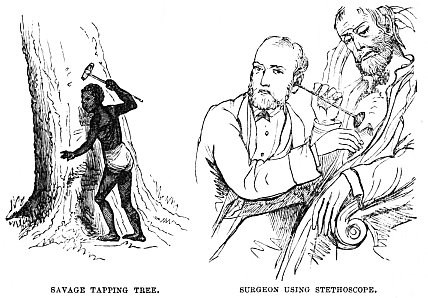
Then, if we examine the various animals which need acute hearing, either to seize prey or escape from enemies, we shall find that they have large and mobile ears, which can be directed so as to catch the expected sound. The hare, rabbit, and deer are examples of the latter, while the former are well represented by the domestic cat, whose ears are always pricked forward when she hears the scratchings of a mouse.
Another most useful appliance is the Stethoscope, which enables the skilful surgeon to investigate the interior of the body almost as clearly as if it were transparent. It is perfectly simple, being nothing but a trumpet-shaped piece of wood, formed as shown in the illustration. Sometimes it is hollow, and sometimes solid, but the result is the same, sound being transmitted through wood in a most remarkable manner.
For example, if one end of the longest scaffolding pole be slightly scratched with a pin, the sound will be distinctly heard by any one who places his ear against the other end, though the person who uses the pin can scarcely hear the sound himself. The surgeon, therefore, places the broad end of the Stethoscope upon the patient, and the other upon his ear, taps more or less lightly with his fingers, and by the sounds transmitted through the Stethoscope ascertains the condition of the internal organs.
On the left hand is an illustration of the mode in which the Australian savage, without the least idea of the theory of Acoustics, utilises the sound-conducting power of wood. If he wishes to know whether or not a hollow tree is tenanted by an animal of which he is in pursuit, he places his ear against the tree, taps it smartly with his tomahawk, and listens for the movement of the animal inside.
So delicate is this test, that it is employed even when the native is hunting for the large beetle-grubs on which they feed, and which are accounted a luxury even by Europeans, when they have once overcome the prejudice attaching itself to eating, without cookery, fat white grubs as thick and long as a man’s finger.
The Aye-aye is said to eat in exactly the same manner, tapping with its long finger the trunks and branches of trees and, if it hears a maggot inside, gnawing it out.
Measurement of SoundOf late years we have had an instrument which enables us to measure the vibrations of sound as accurately as the barometer measures the weight of the atmosphere, the thermometer the temperature, and the photometer the power of light. This is the Siren, which is shown on the right hand of the accompanying illustration.
To explain this instrument fully would require ten times the space which we have at command, and necessitate a great number of drawings. I will, therefore, endeavour to explain its principle in as brief terms as possible.






